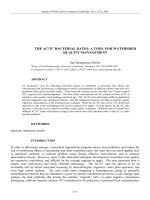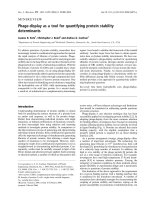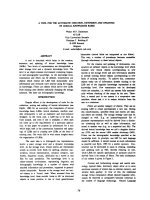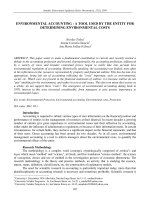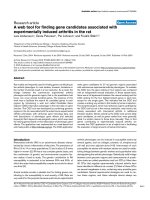Manuscript matcher a tool for finding the best journal proceedings of the 13th international multi conference on complexity, informatics and cybernetics, ISSN 2771 5914,
Bạn đang xem bản rút gọn của tài liệu. Xem và tải ngay bản đầy đủ của tài liệu tại đây (136.2 KB, 6 trang )
Proceedings of the 13th International Multi-Conference on Complexity, Informatics and Cybernetics (IMCIC 2022)
Manuscript Matcher: A Tool for Finding the Best Journal
NAM Nguyen Danh
Thai Nguyen University
Thai Nguyen, 250000, Vietnam
TRUNG Tran
Vietnam Academy for Ethnic Minorities
Hanoi, 100000, Vietnam
TRUNG Nguyen Tien
Vietnam Journal of Education
Hanoi, 100000, Vietnam
THAO Trinh Phuong Thi
Thai Nguyen University of Education
Thai Nguyen, 250000, Vietnam
ABSTRACT
publish open access to get more readers, they should know that
most journals have open access options explained on the journal
homepage. The authors should also submit the paper to only one
journal at the time and check the information about the review
and publication timelines (Beall, 2016).
Additionally, before publishing the paper, the authors should
think about how their research to reach their target audience as
much as possible. Therefore, firstly, the authors take into
consideration the type of article to publish, such as full length,
letter, review, or research results. It should be checked the
references in the paper and then to indicate possible journals of
interest. In general, many factors are influencing the choice of
journal for manuscript submission (Schuemie & Kors, 2008;
Prieto-gutiérrez, 2019). There are many factors involved include
the focus of the journal, the visibility of the journal, the topic of
the manuscript, the impact factor, the timeliness of the editorial
office process and whether the feedback is constructive, journal
accessibility, author costs, and the governance of the journal
(Brandsma et al., 2013; Tullu & Karande, 2018; Beshyah, 2019).
Among these, the impact factor plays a particularly significant
role in choosing a journal. A manuscript matcher recommends a
list of more than ten journals based on the following factors:
scope of the study, target journal type, time to publish,
accessibility, the field of research. Hence, this study aims to
investigate some journal matcher applications and the real
situation of using these services in the Vietnamese research
community.
One of the critical reasons for the rejections of a paper is that the
topic and content of the submitted article are not relevant to the
aims and scope of the journal. Traditionally, the authors select
the journal based on personal experiences, specialist
recommendations, and searching engines. However, with an
exponentially increasing number of papers published every year,
the authors could use supportive tools in finding which journal is
most appropriate for posting their research as well as determining
readers for their work. The authors need to take the crucial
decision of choosing the journal for their prospective manuscript
before even starting to write it. The paper introduces some
popular manuscript matchers and using these tools in
recommending journals in the Vietnamese research community.
The research results have shown that journal choice decisions
influenced by many factors such as time-bound review process,
journal’s visibility, indexation in databases, the regularity of
publication, acceptance rate, and publication fee.
Keywords: Manuscript matcher, journal matcher, journal
suggester, journal recommender, journal selector, finding
journal.
1. INTRODUCTION
Choosing an appropriate journal to publish their research
becomes increasingly difficult for all the authors because of the
significant number of journals (Rison, Shepphird, & Kidd, 2017;
Bahadoran, Mirmiran, Kashfi & Ghasemi, 2020). Moreover,
many journals deal with a wide diversity of topics,
multidisciplinary, open access, and reviewers from many
countries all over the world. The number of authors publishing
one or more papers every year does increase rapidly. Typically,
the authors have to read the aims and scope of the journal on the
website or download a guide for authors to know the format and
standard of the journal (Kang, 2015; Tullu & Karande, 2018). In
particular, the authors could check if the journal is invitationonly. This journal only accepts the paper after inviting the author
to write about a specific topic. However, if the authors need to
ISBN: 978-1-950492-60-2
ISSN: 2771-5914
2. METHODS
To find the best journal, we have analyzed the source of journals
and papers. We randomly selected 10 to 100 (depending on the
number of papers published in each journal) already published
papers from each Springer/Elsevier journal as the input
documents and removed these input documents from the source
database. If the top three or top ten recommended journals
contained the journal in which the input paper published, then
this is counted as a correct recommendation; otherwise, it
counted as a false recommendation. We tested how well journal
matchers predict the journal in which a paper published,
50
/>
Proceedings of the 13th International Multi-Conference on Complexity, Informatics and Cybernetics (IMCIC 2022)
options, journal metrics, review time, acceptance rate, and
production time.
assuming that this journal was the most appropriate one. This test
may not always be the case since many journals overlap
considerably, and many factors may influence journal choice.
The goal of using this research method is to evaluate the
suitability of published articles compared with the
recommendations of journal matcher softwares, from which to
draw some conclusions about the use of these applications for
researchers.
We also used a depth interview of 15 researchers about how to
choose the best journal for the paper. Some questions were given
to these researchers such as: Which manuscript matcher to use to
determine a journal? Which journal is appropriate for their
papers? How to discover the latest papers in the journal? How to
identify and contact the publisher? Does the journal use a precise
type of peer review? Does the journal site require publication fees
and payment methods? Does the journal publicize the members
of the editorial board on their websites? Is the journal open access
and in the Directory of Open Access Journals (DOAJ)? The
results of the interview were analyzed and posed some
problematic issues in the findings and discussion section.
Finding the right journal to submit a paper is one of the most
critical steps during the process of paper publishing. A new
journal information service that makes finding and accessing
journal articles more accessible and more effective than
traditional methods. Smart search technology and field-ofresearch specific vocabularies used to match the paper to
scientific journals. The authors enter the title and abstract of the
paper to find journals that could be best suited for publishing
quickly. Manuscript matchers take all of the data in one place to
provide authors with an easy way to select the appropriate journal
for their publication. It is easy to compare relevant journals to
find the best place for publication. In other words, journal
matchers help give the authors ideas for where to publish their
paper, based on the keywords, abstract, and title the authors write.
The authors insert keywords from their manuscript abstract into
a search engine, which then compares the words to many online
publications. The authors must analyze each of the results
critically to see if they are relevant to their article (Bavdekar &
Save, 2015; Tullu & Karande, 2018). It is significant to note that
many of these sites or applications are promoting their journals
and will likely not give the authors results from other publishers.
In this paper, we present the seven popular manuscript matchers
that help the authors efficiently to find relevant journals for their
papers.
Springer Journal Suggester
This machine () searches
over 2,600 journals of Springer and BioMed Central to find the
most suitable journal for the document. It is easy to compare
relevant journals to find the best place for publication. The
authors need to copy in their abstract or a description of the
research. The authors can then sift through results based on
Impact Factor or whether a journal is open access.
IEEE Journal Recommender
This
machine
()
searches over 170 periodicals and 1500 conferences of the
Institute of Electrical and Electronics Engineers. It compares
critical points such as Impact Factor and Submission-ToPublication Time. It gets all the critical data about IEEE
publications at a glance. No results mean that IEEE is not for the
article. This link also provides the authors IEEE conferences
going to be held all over the world.
Edanz Journal Selector
A Japanese company that offers support to researchers has
created
this
journal
selector
( that can match
the abstract of over 28,000 journals from publishers such as
Springer, Elsevier, John Wiley & Sons, Taylor & Francis, Nature
Publishing Group and more. The authors can also select only
journals indexed in Web of Science, to those that are open access
or offers open access possibilities. Any Impact Factors (Web of
Science) displayed in the search results. Edanz Journal Selector
ranges a broad set of journals. The online tool also offers a
journal selection service in which specialists use their experience
to categorize up to four of the best journals for a given paper.
Enago Open Access Journal Finder
This machine ( />enables the authors to find quality open access journals that are
pre-vetted to protect the authors from predatory publishers. This
free application resolves shared problems on journal authenticity,
predacious journals, and article processing fees by using a
validated journal index provided by The Directory of Open
Access Journals (DOAJ). Enago’s proprietary search algorithm
helps the authors shortlist journals that are most relevant to their
manuscript and research objectives, thus giving the authors the
best chance of publication. After sending the criteria, the authors
receive the top 3-5 journals best suited to their manuscript and
preferences. Additionally, Enago provides the authors with vital
feedback for their manuscript, including suggestions on how to
improve their paper.
Elsevier Journal Finder
This tool is a freely available online application
(), which is one of the most
comprehensive journal recommender systems, covering all
scientific domains and more than 2,900 peer-reviewed Elsevier
journals. It uses semantic search technology and field-of-research
specific vocabularies to match the abstract to relevant Elsevier
journals. This application compares the abstract with all journal
articles in Scopus and recommends up to 50 of the most relevant
journals to consider. Keywords allow the authors to focus their
search. Upon entering keywords, the autofill function helps the
authors to identify which keywords are available in the index,
both for single and combined keywords. This service
recommends if it has published articles that are highly similar to
the article. A list of relevant articles generated, and the tool can
filter on the authors’ preferred criteria, such as open access
Journal/Author Name Estimator (JANE)
This tool is a freely available web-based application
() that, based on a sample text (e.g.,
the title and abstract of a manuscript), can suggest journals and
experts who have published similar articles. BioSemantics Group
manages JANE at the Erasmus University Medical Center in
Rotterdam, the Netherlands. JANE depends on the data in
PubMed, which can contain papers from predatory journals, and
therefore these journals can appear in JANE’s results. To help
51
Proceedings of the 13th International Multi-Conference on Complexity, Informatics and Cybernetics (IMCIC 2022)
the open access journals only, and it usually introduces free open
access journals with high impact factors, more significant
readers, and reputable in the field of research. JANE could give
the author similar papers from all of the journals in the proposed
list based on the title, abstract, and keywords. The author
provided more information about the references and other new
findings related to the paper. JournalGuide is more helpful for
authors because it could find many documents that match the
content of the manuscript from ten years ago. The author could
use these papers for looking back literature review and revise the
draft before sending the document to the most suitable journal.
identify high-quality journals. JANE now tags journals that
currently indexed in Medline and open access journals approved
by the DOAJ. It is also limited to journals included in Medline, a
database published by the United States National Library of
Medicine. Thus, it restricted to biomedical sciences journals.
This one offers an alternative search method for entering the
article’s title and abstract, in which the authors can enter
keywords in a simple search box.
JournalGuide
This application is a free tool ()
designed by a group of former researchers, software developers,
and scholarly publishing veterans at Research Square. A growing
journal database across all academic fields that search, filter, sort,
and compare journals from more than 46,000 titles. Searching by
journal name, publisher, or category, the authors can use the title
and abstract of a paper to discover journals that have already
published articles on similar topics. By matching journals to a
paper’s content, researchers can see which journals would be
most likely to have an interest in their story.
Table 1. Some essential functions of the manuscript matchers
Title
Manuscript
Field of
Open
and
Keyword
Matchers
Research Access
Abstract
Elsevier Journal
Yes
Yes
Yes
Yes
Finder
Springer Journal
Yes
Yes
Yes
Yes
Suggester
IEEE Journal
Yes
Yes
No
No
Recommender
Edanz Journal
Yes
Yes
Yes
Yes
Selector
Enago Open
Access Journal
Yes
No
Yes
Yes
Finder
Journal/Author
Yes
Yes
No
Yes
Name Estimator
JournalGuide
Yes
Yes
No
Yes
3. RESULTS
We selected some critical functions of these applications and
compared the benefits for authors during the process of choosing
a suitable journal. The authors must enter the title, abstract, and
keywords of the manuscript to the input box of the manuscript
matchers. Some optional features the author should be chosen are
a field of research and the reader’s accessibility.
All of these applications could introduce the list of journals if the
author provides title and abstract. Most of them require more
information like keyword, the field of research, and paper
accessibility. We also realized that each application has its
strengths. Enago is one of the non-free applications that it found
Manuscript Matchers
Elsevier Journal Finder
Springer Journal
Suggester
IEEE Journal
Recommender
Edanz Journal Selector
Enago Open Access
Journal Finder
Journal/Author Name
Estimator
JournalGuide
Table 2. Some optional functions of the manuscript matchers
Acceptance Rate
CiteScore
Impact Factor
Publication Time
Database
Elsevier
(2,900)
Springer, BioMed
(2,600)
Yes
Yes
Yes
Yes
Yes
No
Yes
Yes
No
No
No
Yes
IEEE (1,670)
Yes
No
Yes
No
Yes
No
No
Yes
(28,651)
Web of Science, Scopus
(10,700)
Yes
Yes
Yes
No
Medline, DOAJ
Yes
Yes
Yes
Yes
Research Square
months to one year. The papers typically are the output or product
of the research. Therefore, choosing the journal that guarantees
the publication time plays a significant role in the author’s
decision.
We have found that some applications of the publishers tend to
introduce the journals that the publishers are responsible for
publishing and almost do not recommend the article from other
publishers. Such requests are from Springer, Elsevier, IEEE, and
all the databases also from these publishers. Some independent
non-free tools could recommend journals from different
Beside some obligatory inputs, most applications have more
options like acceptance rate or confidence index, CiteScore,
impact factor, publication/review time, and databases. Based on
the publication need, the authors could choose a suitable journal
that satisfying all their requirements. In Vietnam, most
publications are supported by the universities, institutes,
ministries, and Nafosted (abbreviation for National Foundation
for Science and Technology Development) during researching at
ministerial level as well as university level (Tran et al., 2019).
For that reason, the time for requiring publication is about six
52
Proceedings of the 13th International Multi-Conference on Complexity, Informatics and Cybernetics (IMCIC 2022)
databases like Enago, Edanz, JANE, or JournalGuide. However,
all of these tools require the authors to pay a fee for providing
their utilities. This requirement is one of the financial barriers for
most researchers in Vietnam - a developing country.
Moreover, these tools offer more services for authors like
statistical analysis, English revision, paper review, publication
counseling. But non-experience authors could use these services
for improving paper writing skills as well as publishing skills.
The independent non-free tools use big databases to find the most
appropriate journal so that the author could choose the journal
with huge readers all over the world. As a result, it could help the
authors to increase the numbers of followers, impact index, and
cite index (Bavdekar & Save, 2015).
Another scientist at a research institute insisted that:
“We only choose to publish articles in open scientific journals
that are accessible to many scientists, so it is easier for us to
improve the article’s citation index and own citation index. In
addition, publication of international articles may be a
mandatory requirement of scientific research projects with
limited publication time, so we often choose journals with a
limited time to publish articles so that it is consistent with the
plan of the research projects”.
Using journal
finder application
10%
15%
Specialist
recommendation
Table 3. Some priority criteria for choosing the journal
Priority Criteria
Percentage
Order
ISI/Scopus list of journal
7%
5
Acceptance rate or confidence
30%
1
index
Publication time of publication
25%
2
speed
Impact factor, cite score
5%
6
Accessibility (open access), the
10%
4
number of readers
Publication fee
15%
3
Field of research, database
5%
6
Others
3%
7
Total
100%
30%
Personal
experiences
45%
Other sources
Figure 1. Information for submitting a paper on the journal
Besides, only 10 percent of researchers used manuscript matchers
to recommend the journal for publishing their manuscript. It
means that there is only some researchers know how to use these
manuscript matchers in finding publication places for their
research. The other 15 percent of researchers used information
from their colleagues, search engines, books or papers’
references, conferences, forums. Some authors agree to charge
fees for publishing their papers more efficiently. The cost also
could be one of the factors considered while the authors are
selecting the journal. However, some journals routinely do not
charge fees for publication unless the number of pages exceeds a
prescribed limit of a volume.
Results from Table 3 show that the essential factor that the
authors refer to choose the best journal is the acceptance rate or
confidence index. In other words, the authors may want to
consider the acceptance rate as one of the criteria for choosing a
journal for submission. In this study, the authors would submit
the manuscript to the journal if the acceptance rate is more than
50 percent. The second important factor is publication time or
publication speed. Usually, the authors choose the journal that its
review process is around six months. Other factors that may
impact the author’s decision are publication fee, accessibility, the
reputation of the journal (ISI/Scopus list), databases, impact
factor, or cite score. The research has also revealed that nonexperienced authors choose the acceptance rate as the priority;
experienced authors choose the impact factor or cite score in the
ISI/Scopus list is a decisive factor. Some authors were interested
in other factors like editorial board, language, publication
country, the review process. Finally, it is also possible that
journals that do not consider as prestigious have a better
acceptance rate.
The research shows the real situation of using journal matchers
in the researcher community in Vietnam. Surprisingly, 45 percent
of researchers choose the journal based on personal experiences
and 30 percent from specialist recommendation.
Through our interview, a lecturer of a university shared his
opinion as follows:
“We often choose journals in the list recommended by Nafosted
or through the recommendation of colleagues in the same
research field, this is also because we have not known these
search engines. However, there are also scientists who believe
that the wide accessibility of publication determines the selection
of journals”.
5%
3%2%
1%
1%
3%
2%
13%
70%
Elsevier Journal
Finder
Springer Journal
Suggester
IEEE Journal
Recommender
Figure 2. Percentage of using manuscript matchers tools for
choosing a journal
Figure 2 shows that 70 percent of researchers in Vietnam do not
use any manuscript matchers in recommending the journal, and
only 17 percent of authors using seven popular search tools. This
result also fits very few numbers of papers that publish on
ISI/Scopus journals. Recently, Web of Science provides an
invaluable
tool
named
The Master
Journal
List
( to help the authors to find the
right journal which hosted on the Web of Science platform. This
application only introduces journals that demonstrate high levels
53
Proceedings of the 13th International Multi-Conference on Complexity, Informatics and Cybernetics (IMCIC 2022)
professional standing, and review process, among others.
Therefore, journals that include in these databases are considered
to be quality journals and thought to be more prestigious. There
are also many different opinions about choosing
multidisciplinary, interdisciplinary, or single disciplinary
journals. In this study, we have found that the authors in the field
of research, such as mathematics, physics, chemistry, biology
would publish their papers on narrowly specialized journals, and
even they are loyal followers of a specific journal. The authors in
the field of research, such as education, social and humanities,
economics, anthropology, tend to submit their papers on
multidisciplinary journals. However, some researchers think that
interdisciplinary journals are not prestigious. Therefore, using
manuscript matchers to determine the best journal plays a vital
role for authors who want to improve the confidence index as
well as the impact of their papers in the research community.
of editorial rigor and best practice. For that reason, there are only
some researchers using this tool for recommending journal (Tran
et al., 2019).
In Vietnam, some universities and research institutes encourage
lecturers and researchers to publish their papers in prestigious
international journals. Publishers and their journals would like to
invite reviewers from different countries as well as receive papers
of authors from different nationalities so that they could create an
international readership community. Hence, they like to publish
articles in journals that are highly visible and easily accessible to
potential readers. Through the interview, we also found that some
authors believe that the chances of acceptance are generally
higher in journals publishing several issues in a year and have
more pages printed. Assurance of a timely and fair review
process, high visibility, and regular publication of the journal
could consider as some of the other essential features that may
guide the authors’ choice. These results would be appropriate for
a developing country where there are lots of novice researchers
trying to publish their papers on the international journals.
However, this situation would be changed in developed countries
since the differences in publication opportunities for researchers
as well as their leading role in sciences and technologies
development.
REFERENCES
Bahadoran Z, Mirmiran P, Kashfi K, Ghasemi A. Scientific
Publishing in Biomedicine: How to Choose a Journal?
International Journal of Endocrinology and Metabolism,
2020 Nov 25;19(1):e108417. doi: 10.5812/ijem.108417.
Beall J. Best practices for scholarly authors in the age of
predatory journals. Annals of the Royal College of Surgeons
of
England,
98(2),
77-79,
2016.
DOI:
/>Beshyah SA. Authors’ Selection of Target Journals and Their
Attitudes to Emerging Journals: A survey from two
developing regions. Sultan Qaboos University Medical
Journal,
2019
Feb;19(1):e51-e57.
doi:
10.18295/squmj.2019.19.01.010.
Errami, M. et al. eTBLAST: A webserver to identify expert
reviewers, appropriate journals, and similar publications.
Nucleic Acids Research, 35(2), 12-15, 2007. DOI:
/>Juan José Prieto-Gutiérrez, Ten years of research on
ResearchGate: a scoping review using Google Scholar
(2008-2017). European Science Editing, 45(3), 60-64, 2019.
DOI: />Ning Kang, Marius Doornenbal, Bob Schijvenaars. Elsevier
Journal Finder: Recommending journals for your paper,
Proceedings of the 9th ACM Conference on Recommender
Systems,
261-264,
2015.
DOI:
/>Richard A. Rison, Jennifer Kelly Shepphird, Michael R. Kidd.
How to choose the best journal for your case report. Journal
of Medical Case Reports, 11(198), 1-9, 2017. DOI:
/>Sandeep B. Bavdekar, Sushma Save. Choosing the right journal
for a scientific paper. Journal of The Association of
Physicians of India, 63, 56-59, 2015.
Schuemie, M.J. and Kors, J.A. Jane: Suggesting journals, finding
experts. Bioinformatics, 24, 727-728, 2008. DOI:
/>Terry W. Brandsma, Elizabeth R. Bernhardt, Dana M. Sally.
Journal Finder: A solution for comprehensive and
unmediated access to journal articles, Serials Review, 28(1),
13-20,
2002.
DOI:
/>
5. DISCUSSION AND CONCLUSION
It is necessary to realize that every author has different goals for
publication at a specific time. Some authors want to publish a
journal in which their papers could have the most significant
impact on the research community. Therefore, the authors could
use journal matcher tools to analyze every recommended journal
carefully to see if its options help the authors to achieve goals.
Gradually, the reputation of the chronicle plays an increasingly
important part in the decision to choose a journal.
All manuscript matchers with different databases and
publishers/companies, but they have some similar vital functions
such as matching score, impact factor, open access, editorial
times, acceptance rate, and production times. This information
can help the authors to decide which is the best journal to submit
their papers and may reduce the probability of rejection. There
are many other important factors to consider when selecting a
journal. The authors face a problem that it has a low acceptance
rate if they publish their work on a high impact index journal.
The impact factor and acceptance rate usually correlate (the
higher the impact factor, the lower the acceptance rate) (Errami,
Wren, Hicks, & Garner, 2014). However, the authors could use
manuscript matchers to determine other journals with a higher
acceptance rate to increase the chances of being published. Using
journal matchers is a primary method for non-experienced
authors to find and send their manuscripts to the high-ranking
journals. For some researchers, paper submission time is also a
significant factor in choosing the journal. In Vietnam, some
scientific projects (ministerial level and university level) were
deployed in one year or two years and can extend more than six
months. Therefore, some researchers tend to choose a journal that
the submission time is around six months, and usually, the
journal should name in the list of ISI/Scopus journals. This
requirement is a challenge for researchers, especially in the
educational research field.
There are multiple databases that index journals based on various
factors related to quality, the regularity of publication,
54
Proceedings of the 13th International Multi-Conference on Complexity, Informatics and Cybernetics (IMCIC 2022)
Trung Tran, et al. Compliance of education journals in Vietnam
with the minimum criteria to be indexed in the ASEAN
Citation Index and Scopus. Science Editing, 6(2), 142-147,
2019. DOI: />Tullu MS, Karande S. Success in Publishing: Selecting an
Appropriate Journal and Braving the Peer-review Process.
Journal of Postgraduate Medicine, 2018 Jan-Mar;64(1):1-4.
doi: 10.4103/jpgm.JPGM_618_17.
55

